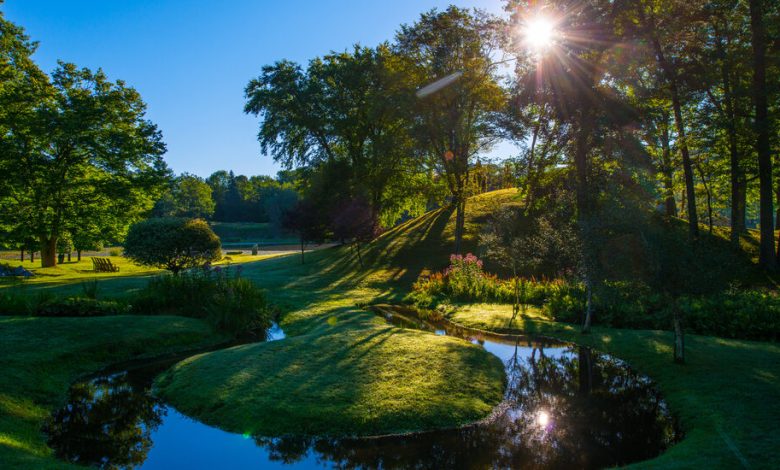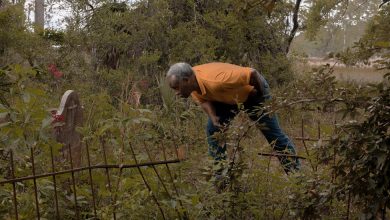Painting With Light: This Garden Shows How It’s Done

Is it time, gardeners, to really see the light?
Navigating the sensory journey that is Innisfree Garden in Millbrook, N.Y., opens our eyes to how powerful a force light can be. And not just in making plants grow, or determining which ones are assigned to areas of sun or shade.
Innisfree’s creators knew that light, when carefully considered, is among the most compelling design tools, capable of creating dynamic contrasts and establishing navigational clues.
The light at Innisfree will move you through the garden — from bright, open spaces to narrower, darker ones — over and again. It will move you emotionally, too.
As if to underscore the point, Innisfree welcomes visitors not just during daylight hours, but for special events several times a year, when the light is at its most remarkable. In the coming weeks, it will open one day at 4 a.m., for a meteor shower before sunrise. And during the autumnal equinox, in September, the garden will hold a moon viewing.

The quality of light at different times of day and in different seasons heightens visitors’ experience of the garden.Credit…Oliver Collins
The 185-acre landscape, which opened to the public in May 1960 and was listed on the National Register of Historic Places in 2019, is a breathtaking glacial bowl. At its heart is a 40-acre lake that catches and reflects the sun and moon like a giant mirror.
Moving in and out of the spaces laid out across its wooded slopes, rocky outcroppings and meadows, we are the beneficiaries of several key garden-making strategies strongly influenced by Asian landscape design. Along the way, we are reminded that every garden is a journey of discovery.
Using light and other raw materials, Innisfree’s makers shaped scenes that pull visitors through the landscape — although many of the cues seem almost subliminal. And each one reads differently depending on the time of day and the season. It’s the light at work.
An English-Style Garden Wasn’t Quite Right
When Walter and Marion Beck established their country estate around 1930, the property encompassed some 950 acres. Near the house they built, Ms. Beck, a keen gardener, and Mr. Beck, a painter and son of a professional gardener, set about creating an English-style garden — complete with a full-time staff of more than 20.
But it wasn’t working. “They decided that it wasn’t right, because they were regularizing all the idiosyncrasies that make this landscape so wonderful,” said Kate Kerin, who has been Innisfree’s landscape curator for a decade and who leads monthly tours.
Mr. Beck had an idea, she said, inspired by his discovery of a scroll painting depicting the garden of the eighth-century Chinese poet and painter Wang Wei, set in similar terrain. He began shaping similar garden moments across the landscape, but they read as individual art pieces without the sense of a journey on the scroll.
It wasn’t until 1938 — when the Becks began working with the landscape architect Lester Collins — that those distinct pictures began to be woven together into a whole.
Mr. Collins added his own elements, too. But not beds or borders of familiar plants — this isn’t that kind of garden. At Innisfree, a well-placed rock (or three) may be all that’s needed. The trio known as the Turtle, the Owl and the Dragon, for instance, draws a visitor’s gaze across the lake from a spot called the Point.
Elsewhere, sunlight refracts through the clouds of mist from a columnar fountain that Mr. Collins set against a cliff, and a 60-foot jet of water erupts among the white pines.
He was as well versed in Modernism as he was in the Romantic period, and in Japanese and Chinese garden history. And the way he thought about design “carefully took into account how our senses work,” Ms. Kerin said.
“You see the whole arc of the day playing out in this bowl. And so, through the course of the day, the light in each area changes really dramatically,” she added. “It doesn’t look like other gardens — and it should feel foreign to gardeners — but they settle right in, and I think light is a big part of that.”
Choose Your Own Path for the Pilgrimage
Overseeing the garden would be a lifelong pursuit for Mr. Collins, who was associated with Innisfree for 55 years, until his death in 1993. His book, “Innisfree: An American Garden,” was published posthumously, a year later.
After the Becks’ deaths in the 1950s, he led the foundation that helped transform the garden into a public space. And despite a sharply reduced budget and staff, he made it substantially larger.
The estate garden had occupied about a quarter of the 1.25-mile lake circumference, but Mr. Collins “wrapped the garden all the way around the lake,” Ms. Kerin said. “He focused our attention on it, and so the way the lake appears and disappears as you experience the overarching landscape is a big part of the experience.”
At the beginning of a visit, we see the whole lake below, from up above in the open. Then, as we start moving down toward it, Mr. Collins created what is “almost a pilgrimage,” Ms. Kerin said.
But there is no single way through the garden.
You could simply circle the lake. Or your path could take a more circuitous route. Ms. Kerin cited something Mr. Collins wrote in his book, referring to “a stroll over serpentine, seemingly aimless, garden arteries. The observer walks into a series of episodes, like Alice through the looking glass.”
Depending on the quality of the light at a particular time of day or year, different areas may draw you in.
“People go all over the place, and that’s partially by design,” she said. “It’s always changing, and that’s how Collins made it. You could take a different path every time; the invitation is there.”
A Native-Heavy Plant Palette
Along the way, in the making of Innisfree, Mr. Collins emphasized another lesson: the importance of carefully evaluating whether any proposed feature is worth its initial cost and effort, as well as the upkeep that will be required to maintain it.
He never sought to make a botanical garden or a museum of plants, although notable remnants of the garden’s earlier incarnation persist — including tens of thousands of daffodils, planted by the Becks before 1959, that welcome spring visitors.
In most of the plants he added or encouraged, Mr. Collins favored what settled in, and spread around on its own.
“His mantra was, ‘How do I make it both sustain and survive public interest?’” Ms. Kerin said. “He needed plants that would succeed, plants that wouldn’t need much maintenance — and that were free.”
Wild blueberries, ferns and mosses prosper. (A visiting moss expert recently stopped counting at 80 species.) Natives like columbine (Aquilegia canadensis), Joe Pye weed (Eutrochium purpureum) and butterfly weed (Asclepias tuberosa) fit his requirements.
In various bog gardens, rose mallows (Hibiscus moscheutos) thrive, and so do pitcher plants (Sarracenia purpurea). Eastern skunk cabbage (Symplocarpus foetidus) is an early-season highlight; in summer, a mass of various introduced water lotus (Nelumbo) sparkle, bobbing at lake’s edge. Japanese primroses, an unnamed yellow Digitalis and common mullein (Verbascum thapsus) are all right at home.
Mr. Collins created some of his biggest effects by subtraction, editing the forest canopy to modulate the way sun reached the ground in key spots. As you walk through the garden, look for the shadow paintings it casts: stark, elongated silhouettes of oak trees and cloudlike puffs of dappled light, like stippling from an artist’s brush.
And then — in key spots and small ways — he added more invitations. By a little cottage, a stand of columnar sugar maples (Acer saccharum Monumentale) form a fiery exclamation in the autumn sun.
Gumdrop-shaped heads of a grouping of Callery pears (Pyrus calleryana Whitehouse), their canopies trimmed hard, mimic the undulations of the ground beneath them, known as Dumpling Knoll, and the curvaceous water’s edge beyond. They catch the light, and our attention.
“He was happy to make something higher maintenance only if it was worth it,” Ms. Kerin said. “Those trees pull all the land forms together, and are the fulcrum of that space.” (Also, the pruning eliminates potential invasiveness, because the trees never set seed.)
However you wend your way through this landscape, you won’t miss the Yarimizu, a dramatic oxbow in a meadow stream, and maybe one of most captivating scenes.
Ms. Kerin describes Innisfree as cinematic — a space that is very much about our bodies in motion, experiencing the garden’s narrative.
“Taking two steps can completely change what something looks like, and that’s on purpose,” she said. “That’s part of the bread-crumb trail that Lester Collins laid out to get you out into it, and get a little lost.”
Shall we accept his invitation?
Margaret Roach is the creator of the website and podcast A Way to Garden, and a book of the same name.
For weekly email updates on residential real estate news, sign up here.





